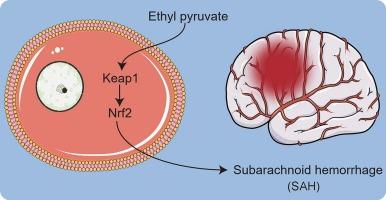Ethyl pyruvate shields the brain from oxidative damage: a Keap1-Nrf2-dependent mechanism in subarachnoid hemorrhage
IF 2.6
4区 医学
Q3 NEUROSCIENCES
引用次数: 0
Abstract
Background
Early brain damage (EBI) is a serious consequence of subarachnoid hemorrhage (SAH). It has been demonstrated that ethyl pyruvate (EP) reduces the early brain damage brought on by SAH. This study investigates the role of the kelch-like ECH-associated protein 1 (Keap1)-nuclear factor erythroid 2-related factor 2 (Nrf2) signaling pathway in the protective effects of EP on SAH-induced early brain injury.
Methods
In this study, we examined the effects of EP on brain damage in a rat model of SAH, including SAH grading, brain water content measurement, neurological function scoring, reactive oxygen species (ROS) levels, and apoptosis. Additionally, we analyzed the involvement of the Keap1-Nrf2 pathway using quantitative real-time polymerase chain reaction (qRT-PCR) and Western blot. Nrf2 knockdown was performed to assess its impact on the therapeutic effects of EP in SAH.
Results
EP treatment significantly alleviated SAH-induced brain damage, including reducing brain water content, ROS levels, and apoptosis, while improving neurological function scores. Furthermore, EP modulated the Keap1-Nrf2 pathway by decreasing Keap1 expression and increasing Nrf2 and HO-1 expression in the brain. Nrf2 knockdown attenuated the protective effects of EP, indicating that Nrf2 activation plays a crucial role in EP’s neuroprotective effects.
Conclusion
EP alleviates oxidative stress and neuronal damage following SAH by regulating the Keap1-Nrf2 signaling pathway. These results demonstrate EP’s potential as a treatment approach that shows promise for enhancing patient outcomes in SAH.

丙酮酸乙酯保护大脑免受氧化损伤:蛛网膜下腔出血中keap1 - nrf2依赖的机制
背景:早期脑损伤是蛛网膜下腔出血(SAH)的严重后果。已经证明丙酮酸乙酯(EP)可以减少SAH引起的早期脑损伤。本研究探讨kelch-like ECH-associated protein 1 (Keap1)-nuclear factor erythroid 2-related factor 2 (Nrf2)信号通路在EP对sah诱导的早期脑损伤的保护作用中的作用。方法:在本研究中,我们研究了EP对SAH大鼠模型脑损伤的影响,包括SAH分级、脑含水量测量、神经功能评分、活性氧(ROS)水平和细胞凋亡。此外,我们使用定量实时聚合酶链反应(qRT-PCR)和Western blot分析了Keap1-Nrf2通路的参与情况。Nrf2敲除对EP在SAH中的治疗效果的影响进行了评估。结果:EP治疗可显著减轻sah诱导的脑损伤,包括降低脑含水量、ROS水平和细胞凋亡,同时改善神经功能评分。此外,EP通过降低Keap1的表达,增加Nrf2和HO-1的表达来调节Keap1-Nrf2通路。Nrf2敲低可减弱EP的保护作用,表明Nrf2激活在EP的神经保护作用中起着至关重要的作用。结论:EP通过调节Keap1-Nrf2信号通路减轻SAH后的氧化应激和神经元损伤。这些结果证明了EP作为一种治疗方法的潜力,有望提高SAH患者的预后。
本文章由计算机程序翻译,如有差异,请以英文原文为准。
求助全文
约1分钟内获得全文
求助全文
来源期刊

Brain Research
医学-神经科学
CiteScore
5.90
自引率
3.40%
发文量
268
审稿时长
47 days
期刊介绍:
An international multidisciplinary journal devoted to fundamental research in the brain sciences.
Brain Research publishes papers reporting interdisciplinary investigations of nervous system structure and function that are of general interest to the international community of neuroscientists. As is evident from the journals name, its scope is broad, ranging from cellular and molecular studies through systems neuroscience, cognition and disease. Invited reviews are also published; suggestions for and inquiries about potential reviews are welcomed.
With the appearance of the final issue of the 2011 subscription, Vol. 67/1-2 (24 June 2011), Brain Research Reviews has ceased publication as a distinct journal separate from Brain Research. Review articles accepted for Brain Research are now published in that journal.
 求助内容:
求助内容: 应助结果提醒方式:
应助结果提醒方式:


